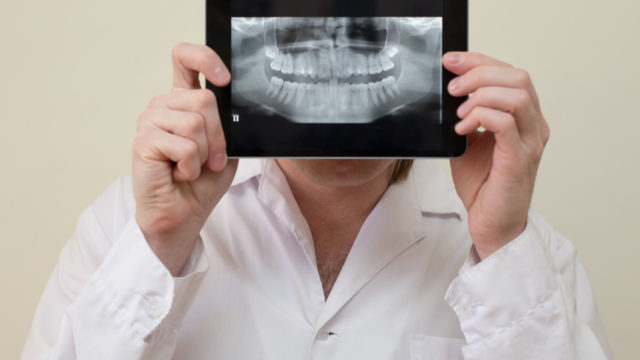
Article at a Glance
- X-rays work by passing rays through the mouth to be absorbed by tissue and bone to produce a radiograph. Problem areas will appear darker than healthy areas on the image.
- There are two main types of x-rays, intraoral and extraoral.
- Dental X-rays allow your dentist to identify potential issues with your teeth, gums, and jaw including cavities, impacted teeth, and tumors. They also help with some treatments, like fitting crowns or implants.
- Modern dental X-rays use the lowest dose of radiation and technological advances have led to additional protections.
Dental X-rays are commonplace and have become valuable tools in dental care. They are one of the first things you’ll have done as a new patient to establish a baseline. You’ll need more over the course of your life depending on your overall oral health and any additional treatment, like orthodontics. This may leave you wondering what exactly are dental X-rays and are they safe?
What Are Dental X-Rays?
Unlike Superman, your dentist can’t see through you, so they rely on X-rays to provide valuable information about the health of your teeth. X-rays work by passing rays through the mouth where they are absorbed by tissue and bone to produce an image, or radiograph, of your teeth. Decay and infections don’t absorb as much as healthy tissue and bone, so they appear as darker areas on the radiographs.
Your dentist can use one of two types of dental x-rays. Intraoral x-rays are the most common and involve film inside the mouth, but extraoral x-rays (film is outside the mouth) can also be useful.
Intraoral X-rays can show many views of your teeth depending on what your dentist needs to see.
- Bite-wing X-rays are used to identify issues between teeth, changes in bone density, and can be used to help fit a dental crown in one area of the mouth. They can show an entire tooth from the crown to the supporting bone.
- Periapical X-rays will reveal any problems with root structure or surrounding bone structure in the upper or lower jaw. They will show the entire tooth from the crown down to where it connects in the jaw.
- Occlusal X-rays show tooth development and placement as well as the arch of the teeth in the upper or lower jaw.
There are also several types of extraoral X-rays.
- Panoramic X-rays allow your dentist to view your entire mouth on a single image. They are useful for determining when teeth are fully emerged, emerging, or impacted.
- Tomograms offer a deeper look at a specific layer of the mouth while blurring the surrounding areas to give your dentist a better look at areas that may otherwise be difficult to see.
- Cephalometric projections involve the side of the head and allow a comprehensive view of the teeth, jaw, and profile of a person.
- Sialography, used to identify issues with the salivary glands, requires a dye to be injected in the glands so they can be seen on the radiographs.
- Computed tomography, or CT scanning, allows professionals to examine your interior structures in a 3D image to identify problems, like tumors, or assist in placement of dental implants.
Why Are Dental X-Rays Necessary?
Dental X-rays help dental professionals identify many issues with the teeth, gums, and surrounding structures, but they can also aid in treatment, especially with difficult cases. Being able to see all the way to the root of a tooth, between teeth, and the full structure of the jaw allow dentists to treat you more effectively and can save you a lot of time, money, and pain. X-rays can help your dentist discover potential issues before they develop into problems requiring treatment.
- X-rays can reveal early signs of decay and difficult to see cavities.
- Since the jaw and sinuses are visible on x-rays, your dentist can see impacted teeth, congenitally missing teeth, cysts, tumors, and problems with your jaw or bone structures that are not otherwise apparent.
- Technological advances and software allow your dentist to enlarge, enhance, and even compare radiographs to get a closer look and show you areas of concern.
- If your dentist needs to refer you to another professional in the same office or across town, they can transfer your radiographs electronically in an instant.
Are Dental X-Rays Safe?
Since X-rays involve a type of radiation, some people may be concerned about the effects of dental X-rays. To begin with, dental X-rays use the lowest dose of radiation, around the same amount as a 2-hour flight on an airplane. Dental X-rays are also taken by trained professionals and there are many safety measures in place to limit exposure.
- Modern machines are smaller, more precise, and well shielded.
- Film is faster and provides a good picture in less time to limit exposure.
- The development of digital X-rays has further reduced radiation.
- Patients no longer need to hold film in place, it’s now done with holders.
- Lead-lined aprons and neck protectors act as shields for the rest of your body.
- Dentists only use X-rays when necessary.
If it’s been a while since you’ve seen a dentist for a regular check-up and professional teeth cleaning, contact the Jefferson Dental Care clinic nearest you to schedule a free new patient exam with X-rays today!




